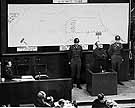
|
|
|

|

|

|

|
|
Click on an image to see a larger, more detailed picture.
|
|
|
|
|
| EPILOGUE: The Aftermath |

|
pg. 691 |

|
|
|
|
| |
 I.G. Farben (diagrammed above) was Germany's largest chemical company. Like other high-profile German businesses, it paid the SS for slave laborers. In the 1990s, Volkswagen, Siemens, BMW, and others reacted to scrutiny by announcing compensatory fund programs for victims and their families.
I.G. Farben (diagrammed above) was Germany's largest chemical company. Like other high-profile German businesses, it paid the SS for slave laborers. In the 1990s, Volkswagen, Siemens, BMW, and others reacted to scrutiny by announcing compensatory fund programs for victims and their families.
Photo: Benjamin Ferencz / United States Holocaust Memorial Museum Photo Archive
|
|
The more one learns about the Holocaust, the more devastating it becomes. Until the late 1990s, for example, it was not widely known that Germany's Deutsche Bank provided lines of credit to help finance construction at Auschwitz. The extensive use of slave labor by German industry in Nazi Germany remains a Holocaust chapter that is still to be fully disclosed. In 1944, for example, 750,000 concentration-camp inmates--about half of them Jews--slaved for German companies. Millions of other conscripted workers, many of them unwillingly deported to Germany and forced to live in cruel circumstances, also served German firms that remain respected for their efficiency and the quality of their products. Essayist Roger Rosenblatt's April 1999 Time article, "Paying for Auschwitz," makes a telling point about the Holocaust's prevailing injustice: "All moral thought," he observes, "is grounded in the possibility of correction. Yet here is a wrong that will never be set right, and people are left groping for something to take the place of the irreplaceable."
|
 In March 1949 the DEGESCH corporation, which made the Zyklon B gas used in gas chambers, was tried in Frankfurt, Germany. Here, Protestant leader Martin Niemöller testifies against the firm.
In March 1949 the DEGESCH corporation, which made the Zyklon B gas used in gas chambers, was tried in Frankfurt, Germany. Here, Protestant leader Martin Niemöller testifies against the firm.
Photo: SYddeutscher Verlag Bilderdienst
|
|
U.S. Undersecretary of State Stuart Eizenstat has no illusions about replacing the irreplaceable. However, he has done a great deal to coordinate international efforts to adjudicate claims about Holocaust-era assets that dominated much of the Holocaust-related news on the eve of the 21st century. On May 20, 1999, for example, Eizenstat presented a 1200-page report of the proceedings from a most important conference on Holocaust-era assets, which was held at the U.S. Department of State from November 30 to December 3, 1998. The conference brought together representatives from 44 countries, including leaders of 13 nongovernmental organizations, art museums, and auction houses. Subsequently, work on related matters has continued, and it will not be finished easily or immediately. Issues about forced and slave labor, for instance, created the agenda for a meeting convened by Eizenstat and German Chancellery Minister Bodo Hombach on May 12, 1999. But the conference in Washington late in 1998 created momentum for ongoing negotiations as well as setting objectives and principles to govern them.
|
|

|

|

|

|
 February 1997: More than 1600 American universities offer courses in Holocaust study, up from 206 in 1979 and two in 1973.
February 1997: More than 1600 American universities offer courses in Holocaust study, up from 206 in 1979 and two in 1973.
|
 February 12, 1997: Switzerland, stung by allegations that the wartime government accepted and laundered funds from Nazi Germany that had been looted from Jews, agrees to create a $71 million fund for Holocaust survivors and their heirs.
February 12, 1997: Switzerland, stung by allegations that the wartime government accepted and laundered funds from Nazi Germany that had been looted from Jews, agrees to create a $71 million fund for Holocaust survivors and their heirs.
|
 February 20, 1997: The Polish Parliament votes to return Jewish communal property nationalized at the close of World War II. Property includes about 2000 synagogues, schools, and other buildings, as well as about 1000 cemeteries.
February 20, 1997: The Polish Parliament votes to return Jewish communal property nationalized at the close of World War II. Property includes about 2000 synagogues, schools, and other buildings, as well as about 1000 cemeteries.
|
 March 1997: Jewish and Polish leaders sign a $93.5 million agreement to preserve and expand the Auschwitz Museum at the site of Nazi Germany's most notorious extermination camp.
March 1997: Jewish and Polish leaders sign a $93.5 million agreement to preserve and expand the Auschwitz Museum at the site of Nazi Germany's most notorious extermination camp.
|
|
|
|
|
| EPILOGUE: The Aftermath |

|
pg. 691 |

|
|
The Holocaust Chronicle
© 2009 Publications International, Ltd.
|
|
